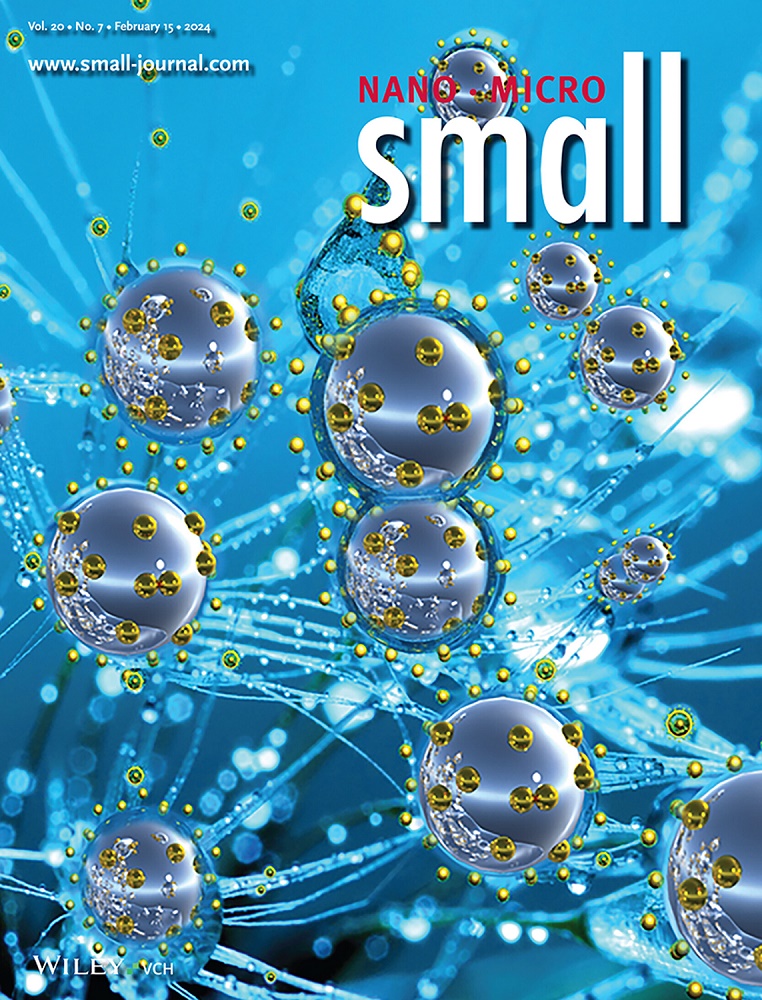Nose-to-Brain Delivery of Acyl-Ghrelin Peptide Gold Nanoconjugates for Treatment of Neurodegenerative Diseases.
IF 12.1
2区 材料科学
Q1 CHEMISTRY, MULTIDISCIPLINARY
引用次数: 0
Abstract
Neurodegenerative diseases remain a major therapeutic challenge in aging populations. Acyl-ghrelin, a 28-amino acid gut hormone, demonstrates neuroprotective effects but is limited by instability, rapid clearance, and non-specific distribution when systemically delivered. Nose-to-brain delivery using nanotechnology offers a promising alternative. Gold nanorods (AuNRs), with high therapeutics loading capacity, are proposed as carriers for intranasal acyl-ghrelin delivery. The previous study demonstrates that intranasal AuNRs effectively reach the brain with minimal systemic exposure. This work investigates the feasibility of using acyl-ghrelin gold nanoconjugates to deliver and retain its pharmacological activity through intranasal administration for neurodegenerative diseases. Acyl-ghrelin is conjugated via its C-terminus to hetero-functional polyethylene glycol (PEG) using EDC/sulfo-NHS coupling chemistry, then attached to AuNRs through stable Au─S bonds. Reaction conditions are optimized to minimize multi-PEG substitution, preserving acyl-ghrelin bioactivity and preventing AuNR cross-linking. The resulting nanoconjugates successfully deliver ghrelin to the brain, reaching peak levels at 10 min post-administration with ≈2067.6 ± 760.6 pg g-1 of brain, a fourfold increase over native expression. Importantly, the peptide retains biological function, as evidenced by AMPK phosphorylation at 30-60 min, a key marker of ghrelin-induced neuroprotection. These findings support intranasal AuNR-mediated delivery of acyl-ghrelin as a promising strategy for treating neurodegenerative diseases.鼻至脑递送酰基胃饥饿素肽金纳米偶联物治疗神经退行性疾病
神经退行性疾病仍然是老年人治疗的主要挑战。酰基胃饥饿素是一种含有28个氨基酸的肠道激素,具有神经保护作用,但由于不稳定、快速清除和全身输送时的非特异性分布而受到限制。使用纳米技术的鼻子到大脑输送提供了一个很有前途的替代方案。金纳米棒(aunr)具有很高的药物负载能力,被提议作为鼻内递送乙酰胃饥饿素的载体。先前的研究表明,鼻腔内的aunr以最小的全身暴露有效地到达大脑。本研究探讨了使用酰胃饥饿素金纳米缀合物通过鼻内给药来传递和保持其药理活性的可行性。Acyl-ghrelin通过其c端通过EDC/ sulo - nhs偶联化学与异功能聚乙二醇(PEG)偶联,然后通过稳定的Au─S键连接到aunr上。优化了反应条件,以最大限度地减少多peg取代,保持酰基胃饥饿素的生物活性,并防止AuNR交联。所得到的纳米偶联物成功地将胃饥饿素传递到大脑,在给药后10分钟达到峰值,脑中≈2067.6±760.6 pg g-1,比天然表达增加了四倍。重要的是,肽保留了生物学功能,AMPK在30-60分钟磷酸化证明了这一点,这是胃饥饿素诱导的神经保护的关键标志。这些发现支持经鼻给药unr介导的酰基胃饥饿素作为治疗神经退行性疾病的一种有希望的策略。
本文章由计算机程序翻译,如有差异,请以英文原文为准。
求助全文
约1分钟内获得全文
求助全文
来源期刊

Small
工程技术-材料科学:综合
CiteScore
17.70
自引率
3.80%
发文量
1830
审稿时长
2.1 months
期刊介绍:
Small serves as an exceptional platform for both experimental and theoretical studies in fundamental and applied interdisciplinary research at the nano- and microscale. The journal offers a compelling mix of peer-reviewed Research Articles, Reviews, Perspectives, and Comments.
With a remarkable 2022 Journal Impact Factor of 13.3 (Journal Citation Reports from Clarivate Analytics, 2023), Small remains among the top multidisciplinary journals, covering a wide range of topics at the interface of materials science, chemistry, physics, engineering, medicine, and biology.
Small's readership includes biochemists, biologists, biomedical scientists, chemists, engineers, information technologists, materials scientists, physicists, and theoreticians alike.
 求助内容:
求助内容: 应助结果提醒方式:
应助结果提醒方式:


